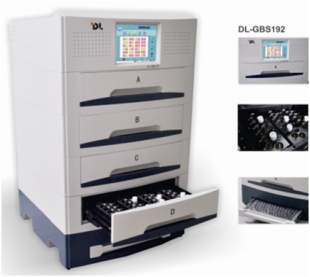MFGTX-ZSQR-GBS is used for the detection of Group B streptococcus, which may cause infection to pregnant women and infants.
Feature & Principle
-Liquid bacteria enhancement, specific chromogenic.
-Fully automated, high-throughput detection.
-Selective chromogenic medium ensures GBS growth.
-Easy to transfer GBS from medium.
MFGTX-ZSQR-GBS
Auto Group B Streptococcus culture and detection system
Method comparison
|
method |
principle |
advantage |
disadvantage |
|
Traditional culture |
Bacterial isolation, plate culture, morpholotical identification, biochemical identification |
Gold standard of bacterial indentification |
Last for over 48h; District process; High culture media requirement; Low sensitivity |
|
Pigmented plating |
Bacterial isolation, pigmentedplate culture |
|
Last for over 48h; District process; High culture media requirement; Low sensitivity |
|
GICA |
Colloidal gold immunochromatography |
Easy operation |
Poor specificity; High false positive rate; Unavailable for further sensitivity test |
|
Fluorescence PCR (BD) |
Integrating PCR technology and fluorescent probe technique |
Report within 2-3 h |
High cost of equipment; High cost of reagents; PCR probe and lab required; High false positive rate. |
|
MFGTX-ZSQR GBS culture and detection system |
GBS pigmented broth and color – observing indicator |
CDC recommended method. High specificity, high sensitivity, high replicability |
|
MFGTX-ZSQR-GBS series specification
|
Model |
MFGTX-ZSQR-GBS 48 |
MFGTX-ZSQR-GBS96 |
MFGTX-ZSQR-GBS192 |
|
Size |
550*540*474mm |
550*540*614mm |
550*540*894mm |
|
Weight |
30 kg |
50 kg |
75 kg |
|
Capacity |
48 cells |
96 cells |
192 cells |
|
Principle |
Colorimetry |
||
|
Specimen |
Secretion from vagina and rectum |
||
|
Incubation Temp. |
37ºC ± 1.5ºC |
||
|
Detection Method |
Independent sensor, detect every 10 min, real-time monitoring |
||
|
Others |
1. Able to load and unload vial at any time on run; 2. Auto-saving data, Auto-detection, Auto-alarm; 3. Growth curve readable; 4. One unit integrated with computer, monitor and incubator; 5. Lunix System |
||
What is group B Streptococcus?
Group B Streptococcus
Gram positive, beta hemolytic bacteria.
Common colonizer of human gastrointestinal and genitourinary tracts.
Recognized as causing disease in humans.
Causes serious desease in young infants, pregnant women.
Emerged as most common cause of sepsis and meningitis in infants <3 months.
Why it is important?
10% - 30% of women are GBS carries
What has U.S. done to prevent it?
1. Publish guidelines for prevention of perinatal group B streptococcal diseases
2. Universal screening of pregnant woman for GBS at 35 – 37 weeks gestational age
The recommendations from
(prevention of perinatal group B Streptococcal Disease, Revised Guideline from CDC, 2010)
Please contact us for more information if needed!


